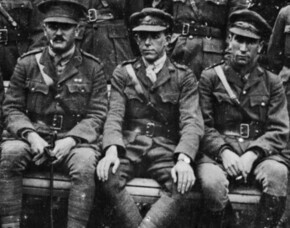GOW, Carl Beeston
| Service Number: | 2261 |
|---|---|
| Enlisted: | 8 June 1915 |
| Last Rank: | Captain |
| Last Unit: | 55th Infantry Battalion |
| Born: | Newcastle, New South Wales, Australia, 1889 |
| Home Town: | Palm Beach, Pittwater, New South Wales |
| Schooling: | Not yet discovered |
| Occupation: | Mail order manager |
| Died: | St Leonards, New South Wales, Australia, 29 October 1970, cause of death not yet discovered |
| Cemetery: |
Mona Vale Cemetery, Northern Beaches Council, New South Wales COE-G-128 |
| Memorials: | Newcastle Surf Club Life Saving Brigade Honor Roll |
World War 1 Service
| 8 Jun 1915: | Enlisted AIF WW1, Private, 2261, 3rd Infantry Battalion | |
|---|---|---|
| 16 Jun 1915: | Embarked Private, 2261, 3rd Infantry Battalion, HMAT Karoola, Sydney | |
| 16 Jun 1915: | Involvement Private, 2261, 3rd Infantry Battalion, --- :embarkation_roll: roll_number: '7' embarkation_place: Sydney embarkation_ship: HMAT Karoola embarkation_ship_number: A63 public_note: '' | |
| 13 Feb 1916: | Transferred AIF WW1, Lance Corporal, 55th Infantry Battalion | |
| 6 Apr 1916: | Promoted AIF WW1, Regimental Quartermaster Sergeant, 55th Infantry Battalion | |
| 9 Feb 1917: | Promoted AIF WW1, Lieutenant, 55th Infantry Battalion | |
| 2 Aug 1917: | Promoted AIF WW1, Captain, 55th Infantry Battalion |
Help us honour Carl Beeston Gow's service by contributing information, stories, and images so that they can be preserved for future generations.
Add my storyBiography contributed by Stephen Brooks
Carl Gow enlisted on 8 June 1915, and was only a week in camp before he left Sydney for the war. He joined the 3rd Battalion on Gallipoli on 30 July 1915, only a week before the Battle of Lone Pine, a scene of ferocious hand to hand fighting over five days. He survived the battle but was reported as wounded days later, on 21 August 1915. He remained on duty for two days before he was evacuated to Mudros.
In an article printed by the Newcastle Morning Herald and Miners' Advocate, during September 1915, Carl Gow’s father had a few words to say about his son’s wounding.
“Mr. Robert Gow, of East Newcastle, has received an intimation from the Defences Department, that his son, Prtvate Carl B. Gow, had been wounded at the Dardanelles. In forwarding the information for publication, Mr. Gow says:--"I may state he enlisted in June last, and was only one weekend In camp, when he left with the 6th Reinforcements of the Third Battalion, on 16th June, arriving In Egypt on 17th July. He spent only seven days in Egypt, and then went to the front, He never had a day's training in his life, and I think greater care should be taken, not to allow untrained lads to go straight into the fighting line, no matter how keen their desire to get there may be. Before he enlisted, my son was employed at Winn and Company's, Oxford Street, Sydney. He was in charge of their country order department. He had been with Winn and Company since he was fourteen years of age. He is now 20.”
Carl rejoined his unit at Gallipoli on 6 October 1915, and was promoted to Lance Corporal on 20 November 1915.
When back in Egypt after the evacuation, Carl Gow transferred to the 55th Battalion as part of the “doubling” of the AIF which took place in early 1916. He was promoted to Regimental Quarter Master Sergeant of the Battalion a few weeks later.
Gow survived the Battle of Fromelles and was promoted again to Second Lieutenant during August 1916 and Lieutenant during February 1917.
He was recommended for a Mention in Despatches during March 1917, for his work as Battalion Quartermaster, for his efforts in keeping the men supplied with hot food, clothing and other comforts during the cold winter of 1916-17 and the advance to the Hindenberg Line.
He was recommended for a Military Cross for meritorious service and devotion to duty for his performance as Quartermaster during the Battle of Polygon Wood in Belgium during September 1917. He had previously been recommended for the same award, for much the same work during the Battalion’s time in around Flers during October 1916.
He was awarded a Military Cross and a Mention in Despatches.
Carl Gow was made an Honorary Captain in August 1917. He was returned to Australia on 17 April 1919. When he finally made it home, it was a few days over four years since he had left his family.









